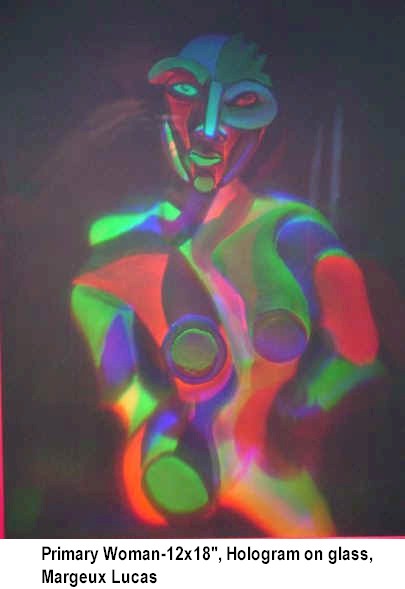
Holography Critiques
PRIMAL WOMAN
Lucas, Circa 1985, 31/1000
 Primary Woman, by Lucas is part of a series, the first of which was Primary Man, a seminal piece, completed a year earlier. Perhaps this is fitting since the order is
biblically correct. The edition was limited to 1000 pieces. Unlike Primary Man which was face only, Lucas sculpted the entire body using some of the vocabulary of Picasso, without imitating him.
Primary Woman, by Lucas is part of a series, the first of which was Primary Man, a seminal piece, completed a year earlier. Perhaps this is fitting since the order is
biblically correct. The edition was limited to 1000 pieces. Unlike Primary Man which was face only, Lucas sculpted the entire body using some of the vocabulary of Picasso, without imitating him.
This work is a fundamental study in colors and mixing and how to use them in holography. Photographs or paintings cannot reproduce the colors that can be produced by the hologram. They are bright, luminous, and complementary chosen brilliantly by the artist to make a striking, almost living, but stylized woman. The plain black background emphasizes the richness and contrast of color and the full contour of the body. One can view this picture for a long time and continue to see more and more new detail from different vantage points.
By deliberately avoiding symmetry Lucas tells us much about her primary woman. Notice that the woman supports most of her weight on her right leg, hands on her hips, an artistic technique first employed by the Greeks in sculpture, known as contrapose. This provides her a classic confidence and determination in herself. Her left eye has a special ring around it denoting some kind of special power. This eye directly feeds the right brain, meaning that she has a special right brain perspective of the world that dominates her left-brain. The special significance for the right leg supports this theory.
Primary Woman's body has a split that runs from her crotch to her neck, a kind of super vagina, illustrating sexual prowess in an abstract way. Much abstract language adorns the figure, such as rings around the breasts, which can be interpreted as shackles that bind her to her role as a mother.
There are many advantages with the hologram over an actual sculpture, some practical and some artistic. The hologram can hang on a flat wall and create a useful space for the sculpture that does not exist in reality, depicting color that never existed on a real model. The original sculpture was always covered in portions of either black or white. The colors are selected by the artist from an imaginary, boundless palette. The original sculpture could be made of soft non-lasting materials, freeing the artist from working in stone or clay.
The series represents some of the earliest art holography that successfully employed a coloring procedure, developed in the early 80’s. Color in holography is still more of an art than science, with few artists having complete control. Holographic images of this type are formed by reflecting light from layers in the photographic emulsion. The color is determined by the separation of the layers. While a variety of methods have been developed to adjust that separation and thereby add color, this particular one employed an emulsion-swelling procedure that is by no means simple chemistry. The model is first covered in black with white added to a portion of it. An exposure is made then the emulsion is swollen by soaking it in a chemical solution. That sets a color for the portion of the model that is colored in white, while the black is not recorded. The white is changed to a new part of the model for subsequent exposures and new swelling amounts for different colors. In principle, many colors could be added sequentially, but two or three are the norm. Secondary colors emerge when two adjacent complementary colors are mixed, so we also see greens, orange and purples.
To the trained eye, Primary Woman can be as mysterious as The Gioconda and should be a lasting work taking an important place in art history.